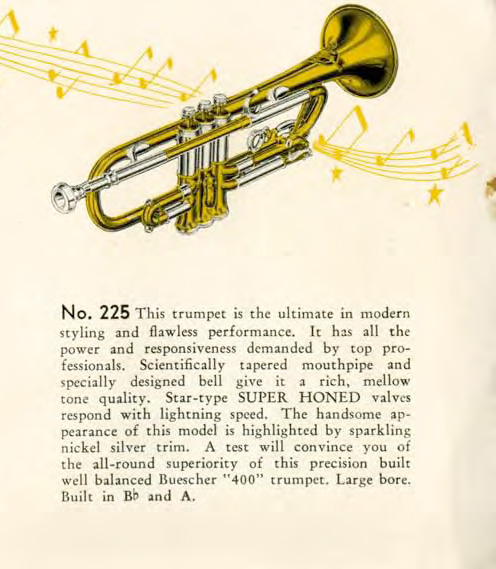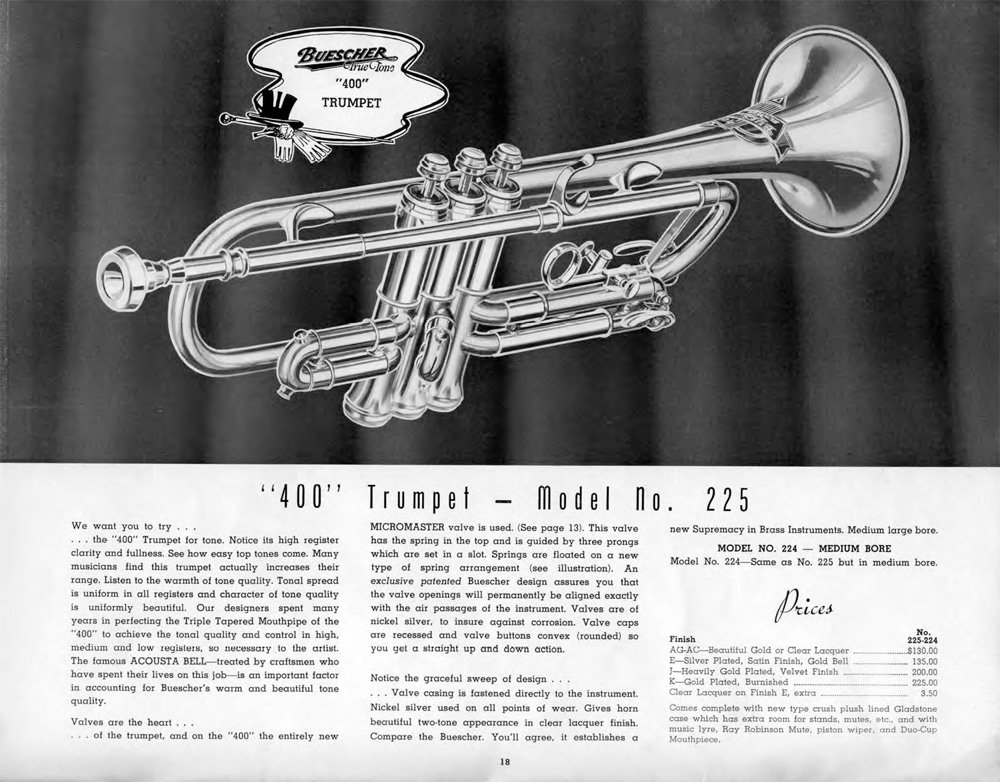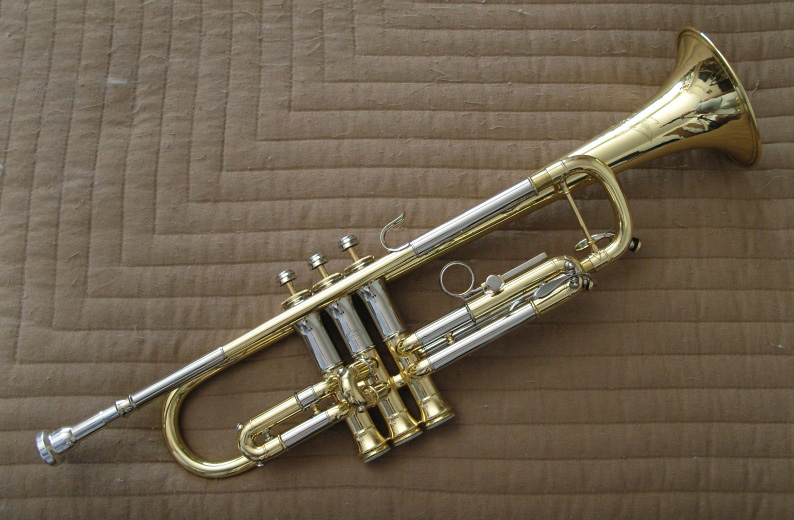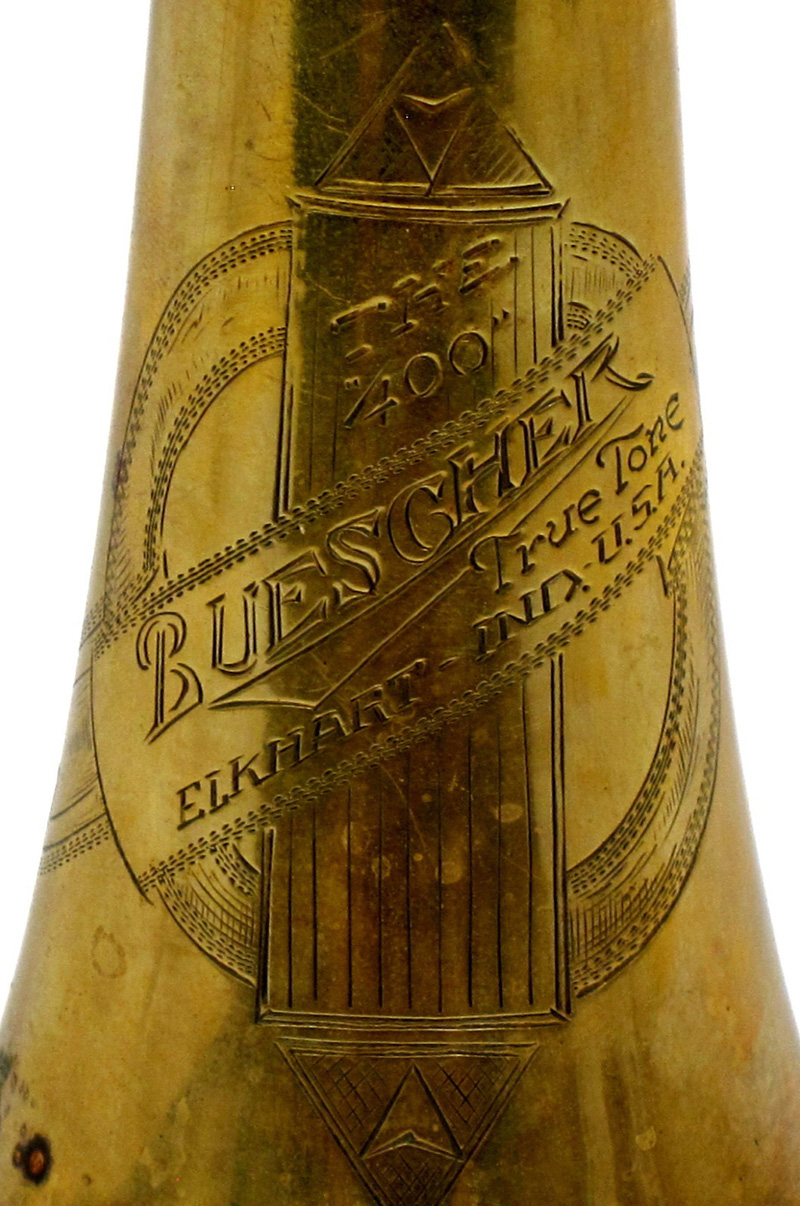Buescher "400" Model 225 / 224
Sold from 1939 until (about) 1956
Some noteable features on this Model
1) Valve block is soldered direclty to the leadpipe and bell.
2) "Pencil" (as I call it) bell logo
3) Brass with Nickel Silver Trim
4) Reverse Wrap
5) Bottom caps and Top Caps are internally threaded so they screw INTO the valve block, this is a feature NOT found on my trumpet models
6) Flared out bottoms of Valve
Tubes
7) Curved water keys
225 was considered a "Large" bore (now a ML bore) and the 224 was listed as a "Medium bore".
225 measures 0.455" at 2nd slide
Sound Description: "It'll play dark to bright depending on mouthpiece and how you play it. Response is very even low to high and it's neither a bright horn nor a dark horn... it's a rich horn with a balance of light and dark." - VetPsychWars (TrumpetHerald / TrumpetMaster)
---1954 Buescher Catalog Excerpt---

--- 1939 Buescher Catalog Excerpt ---

Here is a beautiful example of the 225 owned by VetPsychWars on TrumpetHerald and TrumpetMasters

Described as a "Standard to Heavy weight instrumet", the 225 model in "the 400" line of Buescher's trumpets was considered the cream of the crop top level pro instruments that Buescher made after the "True Tone" name went away.
The 225 measures 0.455" at 2nd Slide
VetPsychWars once described the Buescher 400 line of trumpets in the following manner:
"Buescher horns in general and the Buescher 400 specifically are some darn good horns that play well. But the reason I like mine and some of you others like yours is because it is a very good tool. They have a nice tone and play incredibly well in tune. Amazing intonation... because they have slots a mile wide. If you can play in tune, so will the Buescher. If you can't? You won't like it."
PakWaan on TrumpetMaster.com described his 225 in the following manner:
"I've been playing this horn for a week now, and although I still need more time on it to really "feel it", I find it compares very favorably to my Committees so far. The sound is rich, dark and smoky down low - very much like my '49 Committee. Take it up above the staff and it lightens up when you push it, much like my '40 Handcraft Committee. The sound doesn't have as solid a core as my Olds Recording, but very few horns I have ever played do, although my Fullerton Super probably comes in 2nd place. The slots are fairly loose so it's easy to mess around with pitch when I want to, but not so much that you would have any intonation problems if you weren't doing it on purpose. Perfect for the Miles-style jazz that the Committee is so good at. The resistance feels slightly tighter than the Committee, but very slightly - if I wasn't as intimately familiar with that horn, I probably wouldn't have noticed the difference.
Aesthetically - has there ever been anything sexier than the valve block on a 400? It's a stunning looking horn."
"My daily player is the darkest horn I'd ever touched, my Harrelson Ebony and his first one made. The Buescher 400 is darker. (And no, I don't confuse stuffy and dead w/ this now archaic term "dark")... Pushing myself to my best technique on my own daily player and then trying to do the same thing on a foreign horn is not a fair test, but the 400 stood up to that!?!... I think Buescher's design incorporated a lot of the benefits of modern heavy bracing. I can't imagine heavy valve caps would make a bit of difference, as these valve casings have some seriously thick walls as is. As for dynamic range, I can't find a fault and feel confident saying it'll handle whatever you can dish out.' - Razeontherock (TrumpetHerald)
Here is a YouTube video of Brian Garber playing a 225
Here is another video, this time by World of Brass that highlights many views of the 225
Here is a nice close up of the "PENCIL" Bell Logo that can be found on (I believe) all model 225s. The next 3 pictures a from a 1938 LP 225.





